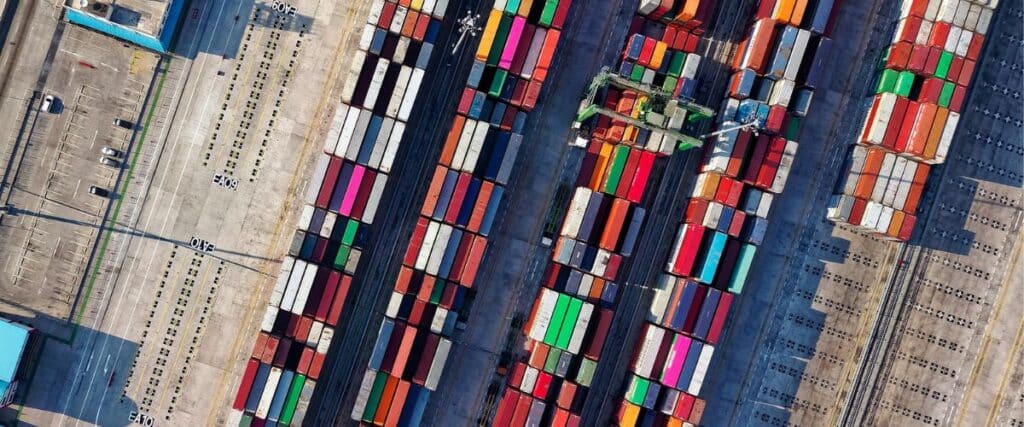
What is Intermodal Transportation?
Efficient intermodal transportation is a logistics strategy that combines different types of transportation to move goods more efficiently, reducing costs and optimizing delivery times. This method allows the advantages of each transportation mode to be leveraged, ensuring more effective supply chain management.
In this article, we explore how combined transportation presents an efficient solution within the intermodal system. By integrating various transportation modes, companies can optimize costs, delivery times, and flexibility.
Next, we will explain the most efficient and widely used methods globally, highlighting those that best adapt to different logistical needs.
Combined Transportation: An Efficient Solution in Intermodal Transportation
Within the intermodal system, there are different types of combined transportation, which take advantage of the best available options to move goods efficiently to their final destinations. The most relevant combined transportation methods include the following:
- Maritime transport + Road transport: This combination is ideal for long international distances, where the ship covers the long distances between continents, and the truck handles the final delivery to the destination.
- Rail transport + Road transport: Primarily used on continental routes, where the train transports large volumes of goods, and the truck handles the final distribution to the destination or distribution center.
- Air transport + Road transport: Perfect for urgent shipments, where the airplane covers long and fast distances, while the truck ensures door-to-door delivery to the final destination.
One of the most commonly used combinations is maritime transport combined with road transport. But how can we optimize this combination to make the most of its benefits?
The Efficiency of Combined Transportation: Maritime and Road
One of the most effective combinations in combined transportation is the one that joins maritime transport and road transport. This combination leverages the economic cost of sea travel for long distances and the flexibility of road transportation to reach the final destination, making a journey where the sea meets the land.
Maritime Transport: The Economic Option for Long Distances
Maritime transport is one of the most efficient ways to move goods over long distances. It is ideal for international trade and particularly useful when transporting large volumes at a low cost.
Advantages of Maritime Transport:
- Cost efficiency: It is the most economical method for long distances.
- Load capacity: It allows for the transportation of large volumes, reducing the cost per ton.
Sustainability: Compared to other modes, maritime transport has a lower environmental impact.
Road Transport: Flexibility and Direct Delivery to the Final Destination
Once the goods arrive at the port, road transport takes over the task of completing the journey to the final destination. This mode is crucial due to its flexibility and the ability to deliver products directly to the customer’s door.
Advantages of Road Transport:
- Route flexibility: It allows for covering specific routes and reaching difficult-to-access areas.
- Door-to-door delivery: Trucks can take goods directly to the final destination, optimizing delivery times.
- Agility: It is ideal for covering the last leg of the journey quickly and efficiently.
To illustrate how combined transportation concepts apply, we present a case study on optimizing transatlantic shipping. This practical example will show how the combination of maritime transport and road transport can significantly improve logistical efficiency, reducing costs and optimizing delivery times.
Key Factors to Consider When Choosing Combined Transportation
Before opting for combined transportation, it is important to evaluate several factors that may influence the decision to use this logistics modality. Although the combination of maritime transport and road transport offers numerous advantages, each situation may require a different approach. Below are some aspects to consider:
- Type of cargo: Maritime transport is ideal for large volumes, while road transport is better suited for specific deliveries.
- Costs: Evaluate the cost-benefit ratio, considering that maritime transport is more economical per ton, but may not be the fastest.
- Delivery time: If speed is important, ensure that the road segment does not delay the final delivery.
- Destination accessibility: Check that the final destinations are well-connected by road to ensure flexibility.
- Simplicity in logistics management: Opting to work with one company that handles both maritime transport and road transport can simplify coordination, reducing the risks of errors and delays. Additionally, it facilitates direct communication, improving visibility and control over the process, which in turn optimizes time and operational costs.
Taking these factors into account will help you maximize the advantages of combined transportation and optimize your logistics operations.If you want more information on best practices and strategies in combined transport, you can check out this article from the International Transport Forum (ITF), a leading organization in studying transport trends and policies.

Challenges of Combined Transportation: Risks You Shouldn’t Ignore
Combined transportation can be an efficient solution, but it is not without its challenges. Without proper management, what seems like an optimal strategy can become a source of logistical problems and unexpected costs:
- Coordination failures: Different providers mean different systems, response times, and priorities. A communication breakdown can result in goods being stranded at a port or warehouse without prior notice.
- Unpredictable delays: Port congestion, customs issues, or lack of truck availability can cause delays that affect the entire supply chain, leading to penalties and loss of customer trust.
- Unexpected costs impacting profitability: Port fees for delays, route change surcharges, and additional storage costs can uncontrollably raise expenses.
To minimize these risks, working with a logistics partner that offers an integrated service is key. With a focus on optimization and full supply chain control, Portex Logistics simplifies combined transportation management, ensuring efficiency, visibility, and personalized solutions for each operation.
With Portex Logistics, you’ll have a team of experts managing every phase of the process, from maritime transport to road transport, guaranteeing efficient and smooth management of your shipments.
Want to take this strategy one step further? Discover how to combine sea and road like a pro. [Click here]
